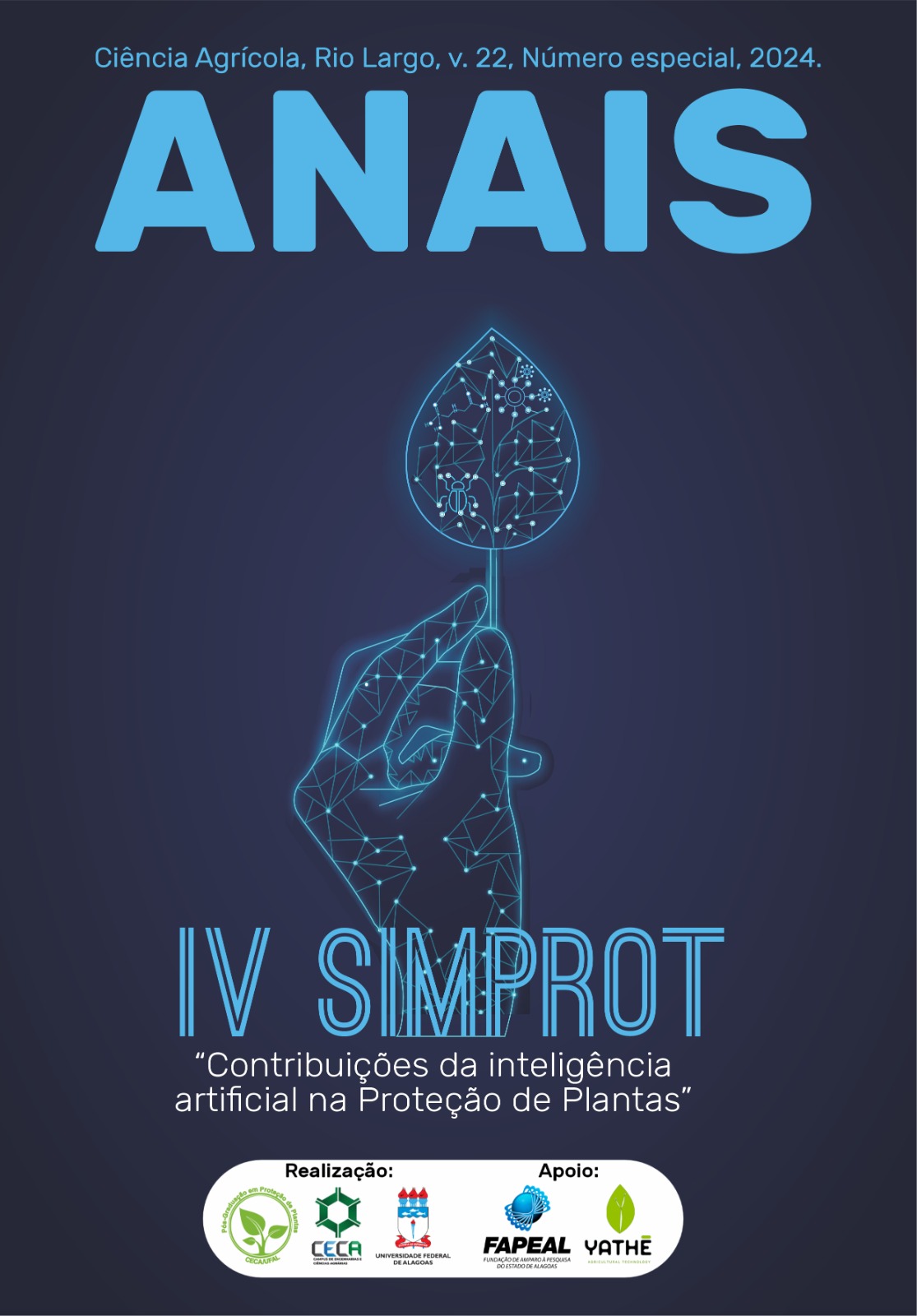USE OF ENTOMOPATHOGENIC FUNGI IN THE CONTROL OF Eueides isabella dianasa (HÜBNER, 1806) (LEPIDOPTERA: NYMPHALIDAE)
DOI:
https://doi.org/10.28998/rca.22.18579Keywords:
Biological control, Passion fruit plant, pest managementAbstract
Outbreaks of defoliating insects, such as caterpillars from the Heliconiinae subfamily, have caused serious phytosanitary problems in passion fruit crops, with Eueides isabella dianasa (Hübner) (Lepidoptera: Nymphalidae) standing out as a major pest that leads to considerable production losses. Despite the importance of this pest, few studies address its management. The objective of this study was to evaluate the potential of entomopathogenic fungi, Beauveria bassiana and Metarhizium anisopliae, in the control of E. isabella dianasa. The bioassays were carried out in the Agricultural and Forest Entomology Laboratory (LEAF) and the Entomology: Alternative Pest Control Laboratory (LECAP) at the Federal University of Alagoas (CECA/UFAL), in Rio Largo, AL. The commercial products Beauveria JCO and Metarhizium JCO WP were tested at concentrations of 0.1 g, 0.5 g, and 1 g. Beauveria bassiana caused mortality at all concentrations, with the highest rate of 60% at the 1 g concentration. In contrast, Metarhizium anisopliae resulted in only 10% mortality at the 1 g concentration, showing no effects at the other concentrations. The results indicate that these fungi have potential for the management of E. isabella dianasa, but further studies with different concentrations are needed to enhance their application in pest control programs for passion fruit crops.
Downloads
References
AGROFIT. Sistema de Agrotóxicos Fitosanitários. Ministério da Agricultura, Pecuária e Abastecimento. Disponível em: https://agrofit.agricultura.gov.br/agrofit_cons/principal_agrofit_cons. Acesso em: 15 nov. 2024.
Alves, S. B. & Lopes, R. B. Microbial Control of Pests in Latin America. Piracicaba: FEALQ. 2008.
Botelho, R. Z., Alves, P. A. B., Colonhez, P. A., Zucchi, R. M. I., Delalibera, J. I. Metarhizium species in soil from Brazilian biomes: a study of diversity, distribution, and association with natural and agricultural environments. Fungal Ecology, 2019, 41, 289-300.
Bueno, A. F et al. Pesticide selectivity to natural enemies: Challenges and constraints for research and field recommendation. Ciência Rural, 2017, 47, 1-10.
Cunha, F. et al. Patogenicidade de dois fungos Metarhizium anisopliae e Isaria farinosa em Brassolis sophorae (Lepidoptera: Nymphalidae). Científica, 2014, 42, 2, 143–146.
Fernández Arcela, Daniel Júnior. Efeito de duas concentrações de Beauveria bassiana Balsam e Metarhyzium anisopliae Metschnikoff no controle de Dione juno Cramer. Tese (Doutorado em Agronomia), 2023.
Kogan, M. Integrate pest management historical, perspectives and contemporary developments. Annual Review of Entomology, 1998, 43, 243-270.
Mingbo, Q. U. et al. Bioinsecticides As Future Mainstream Pest Control Agents: Opportunities And Challenges. Frontiers of Agricultural Science & Engineering, 2022, 9, 1.
Oliveira, C. M.; Frizzas, M. R. Principais pragas do maracujazeiro-amarelo (Passiflora edulis f. flavicarpa Degener) e seu manejo. Planaltina, DF: Embrapa Cerrados, p.43, 2014.
Santos, R. S.; Fazolin, M. Cultura do maracujazeiro no Estado do Acre. Embrapa Acre, 2021.
Tirira Aldaz, P. A. Beauveria sp. como agente de control biológico del gusano defoliador dione juno andicola (bates) en passiflora ligularis (juss.) a nivel de laboratorio. Tese de bacharelado 2022.
Zevallos, M. J.; Cango, N. M.; Larraburre, D. W. Patogenicidade de Beauveria bassiana (Bals) Vuill., sobre o gusano desfolhador do maracuyá Dione juno (Cramer) (Lepidoptera: Nymphalidae) em laboratório. Ecologia Aplicada, 2013, 12, 2, 75-81.
Downloads
Published
Issue
Section
License
Copyright (c) 2024 Jessica Mariana Silva Costa

This work is licensed under a Creative Commons Attribution 4.0 International License.
Termo de cessão de direitos autorias
Esta é uma revista de acesso livre, em que, utiliza o termo de cessão seguindo a lei nº 9.610/1998, que altera, atualiza e consolida a legislação sobre direitos autorais no Brasil.
O(s) autor(es) doravante designado(s) CEDENTE, por meio desta, cede o direito de primeira publicação da OBRA à Revista Ciência Agricola, representada pelo Centro de Ciência Agrarias da Universidade Federal de Alagoas, estabelecida na BR 104 Norte, Km 35, Rio Largo, Alagoas, CEP 57100-000 doravante designada CESSIONÁRIA, nas condições descritas a seguir:
O CEDENTE declara que é (são) autor(es) e titular(es) da propriedade dos direitos autorais da OBRA submetida.
O CEDENTE declara que a OBRA não infringe direitos autorais e/ou outros direitos de propriedade de terceiros, que a divulgação de imagens (caso as mesmas existam) foi autorizada e que assume integral responsabilidade moral e/ou patrimonial, pelo seu conteúdo, perante terceiros
O CEDENTE mantêm os direitos autorais e concedem à revista o direito de primeira publicação, com o trabalho simultaneamente licenciado sob a Licença Creative Commons do tipo atribuição CC-BY, para todo o conteúdo do periódico, exceto onde estiver identificado, que permite o compartilhamento do trabalho com reconhecimento da autoria e publicação inicial nesta revista, sem fins comerciais.
O CEDENTE têm autorização para distribuição não-exclusiva da versão do trabalho publicada nesta revista (ex.: publicar como capítulo de livro), com reconhecimento de autoria e publicação inicial nesta revista.
O CEDENTE têm permissão e são estimulados a publicar e distribuir seu trabalho online (ex.: em repositórios institucionais ou na sua página pessoal), já que isso pode gerar alterações produtivas, bem como aumentar o impacto e a citação do trabalho publicado.




